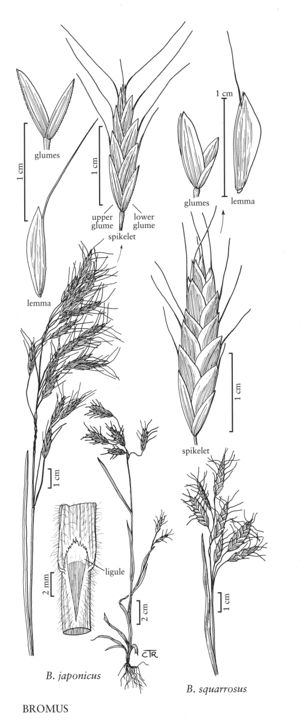Bromus squarrosus
Plants annual. Culms 20-60 cm, erect or geniculately ascending. Lower sheaths densely pilose; ligules 1-1.5 mm, hairy, obtuse, erose, ciliolate; blades 5-15 cm long, 4-6 mm wide, densely pilose on both surfaces. Panicles 7-20 cm long, 4-8 cm wide, racemose, open, nodding, often with few spikelets, usually secund; branches sometimes longer than the spikelets, ascending-spreading, flexuous, slightly curved, usually with 1 spikelet. Spikelets 15-70 mm, broadly oblong or ovatelanceolate, terete to moderately laterally compressed; florets 8-30, bases concealed at maturity; rachilla internodes concealed at maturity. Glumes smooth or scabrous; lower glumes 4.5-7 mm, 3-5 (7) -veined; upper glumes 6-8 mm, 7-veined; lemmas 8-11 mm long, 2-2.4 mm wide, lanceolate, chartaceous, smooth or scabridulous, 7-9-veined, rounded over the midvein, margins hyaline, 0.6-0.9 mm wide, strongly angled above the middle, not inrolled at maturity, apices acute, bifid, teeth shorter than 1 mm; awns 8-10 mm, flattened and sometimes twisted at the base, divaricate at maturity, arising 1.5 mm or more below the lemma apices; anthers 1-1.3 mm. Caryopses equaling the paleas, thin, weakly inrolled or flat. 2n = 14.
Distribution
Wash., Wis., Pacific Islands (Hawaii), Idaho, Oreg., Kans., N.Dak., Nebr., S.Dak., Wyo., N.J., N.Mex., Alta., B.C., Man., N.W.T, Ont., N.Y., Pa., Colo., Ark., Vt., Ill., Ind., Conn., Mo., Mich., Mont., Ky.
Discussion
Bromus squarrosus grows in overgrazed pastures, fields, waste places, and road verges. Native to central Russia and southern Europe, it can be found mainly in southern Canada and the northern half of the United States.
Selected References
None.
Lower Taxa
"decumbent" is not a number.
